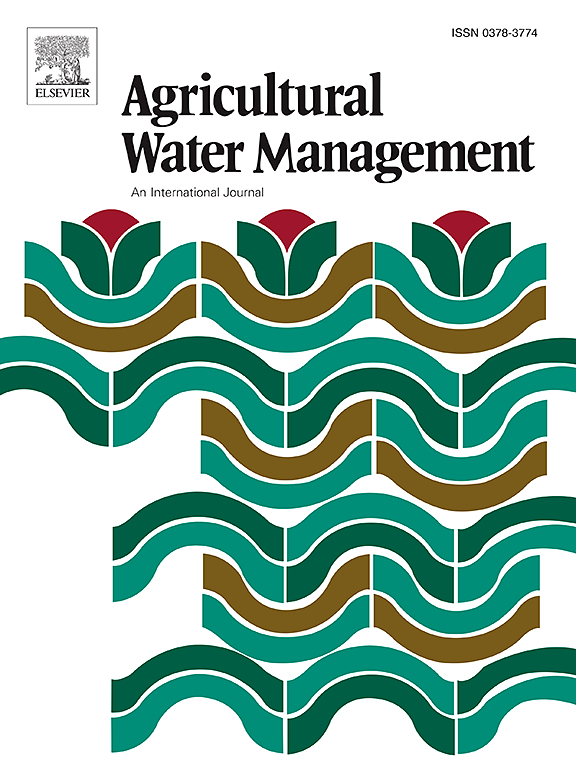西北干旱区明沟与地下联合排水评价:试验数据与规范优化
IF 6.5
1区 农林科学
Q1 AGRONOMY
引用次数: 0
摘要
明沟和地下排水是盐渍土改良的有效措施。目前,中国西北地区的地下排水设施是对地表排水的补充,但其优化尚未进行尝试。因此,通过两年的现场试验,分析了地下排水-明渠联合系统的排水和脱盐性能。然后利用这些数据来校准和验证水和盐的输送模型。地表排水管的排水量是地下管道的9倍。另外,以地下管道长度、埋深和明沟埋深为变量,设计了25组正交数值试验。结果表明,这三个因素对盐碱地脱盐效率影响显著(P <;0.05)。沟深、管长和管深F值分别为9.954、50.286和6.557,三者之间不存在交互作用。采用单明沟排水时,随着离明沟距离的增加,海水淡化率先增大后减小。该拐点随明沟深度的变化而变化,当沟槽深度为180 ~ 300 cm时,拐点出现在32 ~ 43 m范围内。明沟与地下管道的组合可产生更大的海水淡化面积,其效率是单一明沟的170 %。在拐点范围内,淡化速率随沟深的增加而增加。拐点以外以地下排水为主,淡化率随地下排水深度的增加而增加,但沿排水方向保持相对稳定。在组合系统中,地下管道的最佳安装深度为90 ~ 110 cm,沟渠的最佳安装深度为180 ~ 210 cm。长距离地下排水全流最大长度为750 ~ 850 m。该研究为西北干旱地区地下排水-明渠联合系统的优化应用提供了参考。本文章由计算机程序翻译,如有差异,请以英文原文为准。
Evaluation of combined open ditch and subsurface drainage: Experimental data and optimization of specifications in arid Northwest China
Open ditches and subsurface drainage are effective measures for improving saline soils. Installations of subsurface drainage are now complementing surface drainage in Northwest China, but their optimisation has not been attempted. Therefore, the drainage and desalination performance of a combined subsurface drainage-open ditch system was analysed using two years of field experiments. The data were then utilised to calibrate and validate a water and salt transport model. The drainage volume in surface drains were 9-fold those in subsurface pipes. Additionally, 25 sets of orthogonal numerical experiments were designed with the subsurface pipe length, depth, and open ditch depth as variables. The results revealed that these three factors significantly affected the desalination efficiency of saline![]() alkaline farmland (P < 0.05). The ditch depth, pipe length, and pipe depth F values were 9.954, 50.286, and 6.557, respectively, and no interactions were observed among these factors. When a single open ditch was used for drainage, the desalination rate initially increased and then decreased as the distance from the open ditch increased. The inflection point varied with the open ditch depth and occurred within a range of 32–43 m when the ditch depth was 180–300 cm. The combination of an open ditch and a subsurface pipe produced a larger desalination area, and its efficiency was 170 % that of a single open ditch. Within the inflection point range, the desalination rate increased with increasing ditch depth. Beyond the inflection point, subsurface drainage played a primary role, and the desalination rate increased as the subsurface drainage depth increased but remained relatively stable along the drainage direction. The optimal installation depth for subsurface pipes was estimated to be 90–110 cm, and the depth of ditches was 180–210 cm in a combined system. The maximum length for full flow in long-distance subsurface drainage was 750–850 m. This study provides references for the optimal application of combined subsurface drainage–open ditch systems in arid Northwest China.
alkaline farmland (P < 0.05). The ditch depth, pipe length, and pipe depth F values were 9.954, 50.286, and 6.557, respectively, and no interactions were observed among these factors. When a single open ditch was used for drainage, the desalination rate initially increased and then decreased as the distance from the open ditch increased. The inflection point varied with the open ditch depth and occurred within a range of 32–43 m when the ditch depth was 180–300 cm. The combination of an open ditch and a subsurface pipe produced a larger desalination area, and its efficiency was 170 % that of a single open ditch. Within the inflection point range, the desalination rate increased with increasing ditch depth. Beyond the inflection point, subsurface drainage played a primary role, and the desalination rate increased as the subsurface drainage depth increased but remained relatively stable along the drainage direction. The optimal installation depth for subsurface pipes was estimated to be 90–110 cm, and the depth of ditches was 180–210 cm in a combined system. The maximum length for full flow in long-distance subsurface drainage was 750–850 m. This study provides references for the optimal application of combined subsurface drainage–open ditch systems in arid Northwest China.
求助全文
通过发布文献求助,成功后即可免费获取论文全文。
去求助
来源期刊

Agricultural Water Management
农林科学-农艺学
CiteScore
12.10
自引率
14.90%
发文量
648
审稿时长
4.9 months
期刊介绍:
Agricultural Water Management publishes papers of international significance relating to the science, economics, and policy of agricultural water management. In all cases, manuscripts must address implications and provide insight regarding agricultural water management.
 求助内容:
求助内容: 应助结果提醒方式:
应助结果提醒方式:


